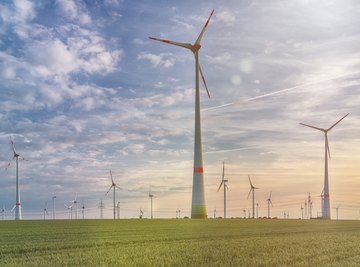
Natural renewable resources are big business as the planet’s resources deplete. Earth’s ever-growing population will peak and begin declining later in the 21st century, but that does little good today as the need for resources escalates.
The last four decades have been the greatest period of change in human history, during which time the population almost doubled from 4 billion in 1973 to 7.7 billion today, and the digital revolution transformed how we live and the resources (and energy) we require. Industry can radically improve the world by using naturally renewable resources in a sustainable way, but what’s renewable, and what’s not?
What Are Natural Resources?
The Renewable Resources Coalition describes natural resources as “materials and substances that occur naturally and can be used for economic gain. They include minerals, forests, fertile land, and water. Some natural resources, such as soil and water, are essential for the existence of life.”
There are both renewable natural resources and nonrenewable natural resources. The difference between them is whether the resource can be naturally replaced during our lifetime or if it’s gone for good once consumed. The struggle with renewability comes from the realization that many of our resources are being depleted too fast to recur naturally, as with forests in some regions or with resources like oil and minerals that take hundreds if not thousands or even millions of years to replenish.
Western society did not take the long view on resources for most of the industrial era, and current ecological realities are making sustainability a hot topic – one for which consumers have overwhelmingly shown a willingness to pay a premium.
A Natural Resources Glossary
- Renewable resource: A natural resource that can be replaced or replenished within a few decades, such as timber. Typically, these are things like plants and animal-derived products.
- Nonrenewable resource: When resources are unable to renew in a matter of decades or those that may be gone forever once harvested or utilized. These come from fossils, minerals or soils.
- Organic renewable resource: When renewable resources come from living things, they’re considered organic, such as manure.
- Inorganic renewable resource: These are nonliving resources like solar power, wind energy and hydroelectric energy.
Most-Used Natural Resources
Here’s a nonrenewable and renewable resources list, in no particular order, containing some of the world’s most-used resources.
Copper
One of the few metallic elements that naturally occurs in its native forms, copper has been used for thousands of years. Today, it’s big industry in America, which is its second-largest producer. Copper suffers no reduction in quality during recycling, making it as valuable when used as it is when new. It’s not a renewable resource, but it never deteriorates in quality.
Helium
The solar system’s second-most abundant element is a critical gas used for far more than just inflating party balloons. Used as a gas to cool the Large Hadron Collider and for making superconductor magnets in things like MRI machines, helium is a finite resource that plays an important role in today’s technologies.
Coal
This fossil fuel was used in heating for centuries but is now used in electricity production thanks to its low cost and high-energy output. Unfortunately, coal is nonrenewable, and mining for coal is also a highly destructive activity that results in toxic groundwater and air pollution.
Salt
Known as sodium chloride, only 20 percent of the planet’s mined salt winds up on tables or in food production. The other 80 percent is evenly split between industrial uses and road deicing. Salt can be extracted from the sea but is also mined as a mineral. It is nonrenewable.
Oil
Arguably the most important fuel powering our world today, oil is used in production of jet fuel, propane, diesel, asphalt and gasoline. It also makes the petrochemicals for making synthetic rubber, chemicals and even plastic.
A nonrenewable resource, discoveries of oil reserves are slowing down, while the population boom and increasing wealth means more cars and other fuel-guzzling machines in use than ever before. Based on the world’s known oil reserves, British Petroleum estimates that the 1.6 trillion barrels they believe exists will be enough to power the world at today’s consumption rates for another 50 years or so. Hence, this is why the race is on for renewable energy sources and the electric car.
Timber
Wood builds our homes and our furniture, and it plays a part in so many other products too, like paper. Technically, wood is a renewable resource, but it’s among the most exploited resources because it takes decades for forests to re-establish. Sustainable forestry happens in many regions, but ecosystem-destroying practices are common too. With sustainable practices and quick-growing varieties, forestry can be a renewable resource.
Soil
A nonrenewable resource, soil is critical for food production. As the Renewable Resources Coalition writes, “Soil is essential for the function of ecosystems providing nutrients, oxygen, water, and heat. Soil resources are being degraded by poor agricultural practices and chemical contamination. One of the most significant challenges facing current and future generations is the preservation of this irreplaceable natural resource from pollution and physical destruction.”
Renewable Energy Resources
The age of oil may still be here, but with the pollution from combustible engines and dwindling reserves, the rush for renewable energy has gone full throttle. Luckily, advances come so fast and furious that it’s hard to keep up with the renewable energy news. Renewable energy sources include:
Biomass
One of the biomasses in use is an incredible reinvention of garbage. “Municipal solid waste” is the product converted in the biomass sector, which is essentially household trash. In 2015, 262 million tons of trash were able to be converted into energy, compost and recyclables.
Food waste creates methane gas, a greenhouse gas 23 times more potent than C02, so composting is a huge part of reducing methane gases in the atmosphere, plus it enrichens soil, which is a threatened, nonrenewable natural resource.
Other biomasses include wood and wood waste, ethanol and other biofuels.
Solar
For a long time, harnessing the sun’s energy had limited appeal because it was unable to be stored. Some of today’s batteries allow for solar energy to be converted and stored, causing a boom in solar plants and use of solar panels on everything from street lamps to private homes. Solar has its drawbacks, as sunlight is not constant or predictable, but using other renewable energy sources in concert with solar has proven extremely successful in countries like Germany, where clean energy is booming.
Wind
Wind energy is harvested around the world now. Most people are surprised to learn that wind energy turbines need wind to blow only at an average of 9 miles per hour for energy to be harnessed. A single commercial wind turbine can power as many as 1,600 houses.
Geothermal
Geothermal energy uses the Earth’s internal heat to create energy and provide heat. This is especially useful in places with volcanic evidence, like Portugal’s Azores Islands, where they are 85 percent energy independent thanks to their geothermal stores.
Hydropower
Using energy from water’s flow has generated power on land for decades thanks to hydroelectric dams, which convert energy when river water drops from one level to another. At sea, scientists are capturing wave energy too. This technology hasn’t been realized to its full capacity, but the potential is phenomenal. The U.S. Energy Information Administration estimates that the wave potential for the offshore U.S. could power 66 percent of the nation’s homes one day.
References
About the Author
Steffani Cameron is a nomad, writer, photographer, from Vancouver, Canada, who is slow-travelling the world for five years. Her work has appeared in Washington Post, Vox Media, Kitchn, About, and more.
